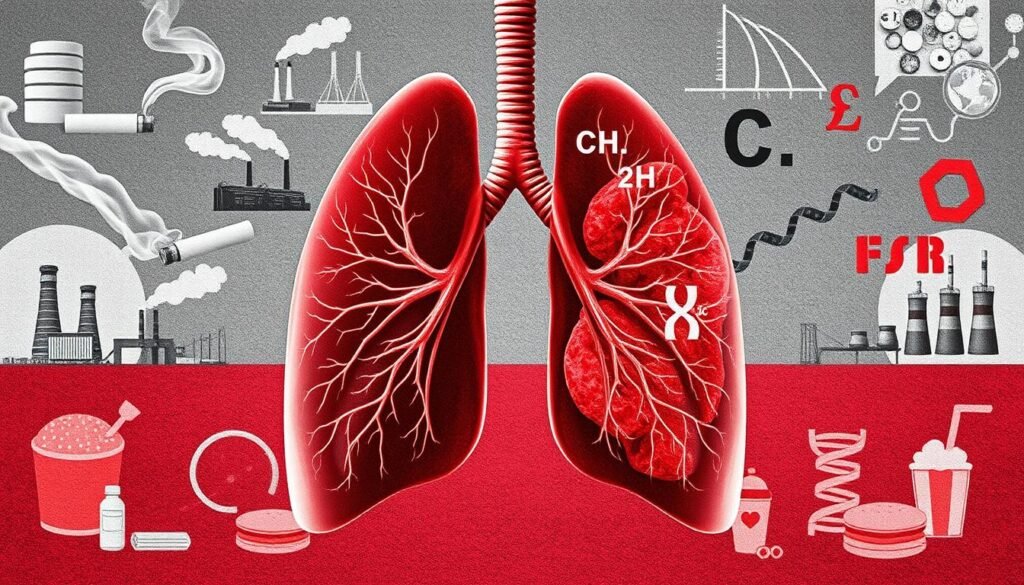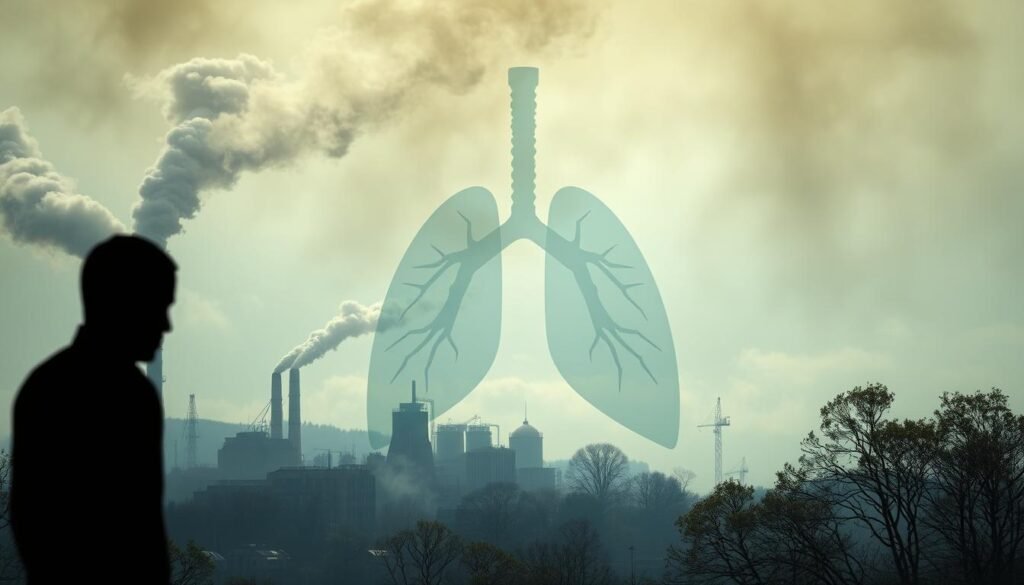Did you know about 1.61 million people get lung cancer every year? This big number shows how important it is to know and understand lung cancer. It is the top reason people die from cancer, affecting men a lot. Many wonder if lung cancer can spread from one person to another. This question comes from not fully understanding the disease and its causes. Let’s look into what causes lung cancer, its risk factors, and clear up some wrong ideas about its spread.
Key Takeaways
- Lung cancer affects millions globally, with a high mortality rate.
- Understanding lung cancer is crucial for effective prevention and risk reduction strategies.
- Common misconceptions about cancer transmission need to be clarified.
- Lung cancer is primarily caused by genetic and environmental factors.
- Smoking is the leading risk factor for lung cancer development.
- Lung cancer cannot be transmitted from one person to another.
Lung Cancer Overview
Lung cancer leads to the growth of abnormal cells in the lungs. This disease causes more deaths than breast, colon, and prostate cancers together. The lung cancer overview splits into two kinds: non-small cell lung cancer (NSCLC) and small cell lung cancer (SCLC). NSCLC is more common, but SCLC makes up roughly 20% of cases.
According to lung cancer statistics, around 236,000 new cases were reported in the U.S. in 2022. This shows it’s a leading cause of cancer deaths. Smoking is a big risk factor, linked to about 90% of cases. Lung cancer usually affects older adults, rarely those under 45.
Secondhand smoke, air pollution, and exposure to asbestos and radon can raise lung cancer risks. Common symptoms include a lasting cough, chest pain, and difficulty breathing. Often, lung cancer is found when doctors are checking for other health issues.
Treatments for lung cancer depend on its type and stage. They can include surgery, drugs, or radiation. Though treating lung cancer is challenging, new methods are helping patients live longer.
What Causes Lung Cancer?
Lung cancer can start due to many reasons, but smoking is the top one. Cigarettes have harmful substances that damage our lungs. Most lung cancer cases in Australia come from smoking. Not just smokers, but those around them also face a greater cancer risk.
Air pollution, asbestos, radon, and heavy metals are other big causes. If you already have lung problems, like COPD, your risk goes up. It’s interesting to note that 85% of lung cancers are non-small cell lung cancer (NSCLC).

Being older than 60 increases your lung cancer chance. So does having lung cancer in your family. Vaping may seem less risky, but it could lead to cigarette smoking. This triples the chance of lung cancer.
To prevent lung cancer, avoid carcinogens and quit smoking if you do. Resources like articles on cancer risks help us learn how to steer clear of cancer causes.
Genetic Factors Contributing to Lung Cancer
Genetics play a big role in lung cancer. You can get it from family traits or environmental damage that changes genes. Some mutations are inherited and show a family might be at higher risk. Those with lung cancer in their family should look into genetic counseling.
Somatic mutations happen over a person’s life. They often come from things like smoking or pollution. These can harm DNA, causing cells to grow wrong and lead to lung cancer. Looking at both germline and somatic mutations helps find who’s at high risk.
Knowing about genetic factors helps with cancer risk checks. It can guide personal treatment plans. As science gets better, tackling these genetic aspects is key. It helps fight lung cancer for everyone.
Environmental Risk Factors for Lung Cancer
Different factors in the environment can seriously raise the chance of getting lung cancer. Air pollution is a big one, as it’s a major cause of cancer and other diseases without spreading between people. Globally, air pollution causes about 7 million deaths every year. A large number of these deaths are due to lung cancer and breathing problems.

Workplaces with certain harmful substances also pose a big risk. For example, being around asbestos and arsenic can make workers more likely to get lung cancer. On top of that, radon gas in homes and buildings increases cancer risk too. It’s key to know about these dangers to prevent them effectively.
Smoking tobacco makes the situation worse when combined with these environmental risks. If a person smokes and is also exposed to these carcinogens, they’re much more likely to develop lung cancer. This shows why it’s critical to tackle both smoking and environmental dangers together.
For more information on recognizing early warning signs, visit this resource.
| Environmental Factor | Risk Associated | Preventive Action |
|---|---|---|
| Air Pollution | Causes lung cancer and other NCDs | Advocate for cleaner air regulations |
| Radon Gas | Increases lung cancer risk | Install radon detectors in homes |
| Asbestos | Linked to lung cancer and mesothelioma | Ensure safe removal in buildings |
| Arsenic | Occupational exposure linked to lung cancer | Improve workplace safety standards |
Understanding the Question: Is Lung Cancer Infectious or Noninfectious
It’s vital to clear up misconceptions about cancer transmission to support those diagnosed. Many believe lung cancer is contagious, leading to fear and stigma. Knowing the truth helps everyone.
Clarifying Misconceptions about Cancer Transmission
Cancer, including lung cancer, is not catchable. You can’t get it from touching, being intimate, or sharing spaces. Cancer is not like communicable diseases. Some cancers run in families due to genes or lifestyles, not because they are contagious. This shows how vital support is for affected people.
How Lung Cancer is Not Spread Through Contact
Some infections increase cancer risk, but cancer isn’t contagious. Even in rare cases like contaminated cell growth in organ recipients, common social actions like kissing or sharing meals don’t spread cancer. Research shows the link between cancer in organ recipients and immunosuppressive drugs, not cancer cell transfer.

| Aspect | Contagious | Noncontagious |
|---|---|---|
| Cancer Transmission | No | Yes |
| Close Contact | No | Yes |
| Common Household Settings | No | Yes |
| Genetic Factors | No | Yes, shared risk factors |
| Support Needs of Patients | No | Yes |
Telling people the truth about cancer reduces stigma. For more on cancer not being infectious, check this resource for comprehensive information.
Can Infections Lead to Lung Cancer?
Lung cancer doesn’t spread from one person to another. However, infections and lung cancer risk are closely related. Viruses and bacteria might play a role in cancer formation. Yet, how infections directly impact lung cancer is still somewhat of a mystery.
There’s a back-and-forth relationship between chronic obstructive pulmonary disease (COPD) and infections. The “vicious circle hypothesis” explains how COPD exacerbations are linked to infections. These exacerbations may involve pathogens like Haemophilus influenzae and Streptococcus pneumoniae. New strains, especially of H. influenzae, intensify these situations.
Bacterial colonization could influence the progression of COPD. Reports show higher NTHi rates in patients compared to healthy folks. This could hint at a possible connection between these infections and lung cancer. Additionally, COPD sufferers tend to have weaker immune responses. This is a concern since about 2% of cancer deaths in the U.S. are due to infections.
Worldwide, about 16.1% of cancers are linked to infections. Human papillomavirus (HPV) is notable for leading to cervical cancer and others in the U.S. This highlights the importance of understanding cancer pathogens in assessing lung cancer risks. The direct link may not be proven, but the connection is undeniable.
| Cancer Type | Infectious Agent | Risk Percentage |
|---|---|---|
| Cervical Cancer | Human Papillomavirus (HPV) | Majority |
| Gastric Cancer | Helicobacter pylori | 1-2% |
| Liver Cancer | Hepatitis B and C Viruses | Estimated 40,710 new cases (2017) |
| Lung Cancer Mortality | Various Infectious Causes | 2% |
Infections and lung cancer may not be directly linked, but studying chronic infections is key. Ongoing research into cancer pathogens could shed light on preventing or managing lung cancer.
Lung Cancer Clusters: Fact or Fiction?
Some areas report lung cancer clusters, causing worry among those who live there. Often, these clusters don’t actually show an increase in cancer rates compared to norms. Experts link them to things like environmental exposure, lifestyle choices, or genes.
In cancer epidemiology, it’s key to understand how cancer clusters form in neighborhoods. Studies focus on clusters in homes, not workplaces or hospitals. Over 166 articles provide insights on addressing community cancer concerns.
Dealing with these clusters involves steps: respond, assess, study, and investigate. This process helps thoroughly check each case. It’s based on guidance from public health experts and the CDC.
Community cancer patterns need solid research methods and tech. Data analysis and mapping are crucial. Modern tech like the Internet helps inform people. Open communication can lessen fears about lung cancer clusters.
If you notice signs like coughing or weight loss, getting checked is vital. Early detection can greatly improve treatment success. Find out more about these signs related to lung cancer.
Prevention and Risk Reduction Strategies for Lung Cancer
Effective lung cancer prevention involves addressing risks that can be changed. People can lower their lung cancer risk by making key lifestyle changes. Quitting smoking is one of these important changes. It’s especially crucial because two out of every three deaths in long-term smokers are from smoking.
Avoiding secondhand smoke also cuts down on exposure to dangerous toxins. This greatly helps in lowering cancer risk.
Choosing a healthy lifestyle cancer approach is more than just not smoking. It also involves eating well. Good nutrition has a big role in stopping cancer. Drinking less alcohol also helps, since it’s linked to about 4.5% of cancers. Being active fights obesity, which is linked to many deaths from diseases each year.
Don’t ignore workplace safety. Being around carcinogens, like asbestos, increases cancer risk. Knowing about your environment and staying safe is key. Pollution and job dangers show why everyone should know how to reduce risks.
Educating families and communities builds support for lung cancer prevention. Encouraging regular check-ups helps catch cancer early, leading to better survival rates. Making healthy choices can prevent many cancers. There’s a lot more to learn about preventing lung cancer from reliable health sources.
Using these strategies helps build a healthier society by lowering lung cancer rates. For more information on lifestyle and cancer, check out articles and stats at this link.
Conclusion
Lung cancer is a complex disease often misunderstood by many. It makes up 11.6% of all cancer cases worldwide, according to GLOBOCAN 2018. Knowing the big impact of both the environment and genetics is key, instead of just thinking it spreads like a virus. Public education helps clear up myths and teaches the real facts about lung cancer, which doesn’t spread from person to person.
Pulmonary infections and lung cancer are linked, but that doesn’t mean one can catch cancer from another person. Understanding chronic inflammation, how the body defends itself, and the effect of our lifestyle choices is critical. This knowledge helps everyone know more about the risks and how to avoid them. It encourages people to make healthy choices and support those who have lung cancer.
Talking more about lung cancer can change how people see it. Showing that early action, raising awareness, and community support make a difference is crucial. This can lessen the shame around the disease. A well-rounded discussion on lung cancer leads to better care for patients and a knowledgeable community.